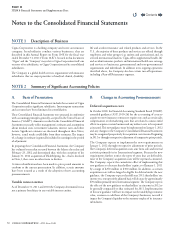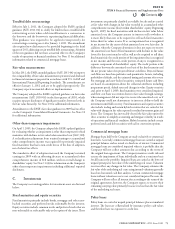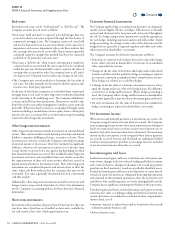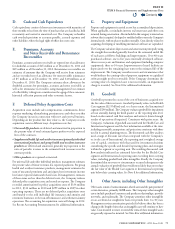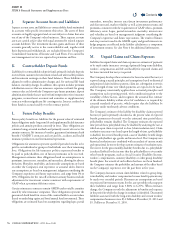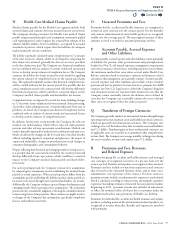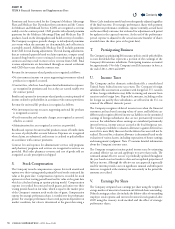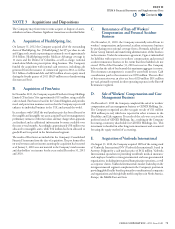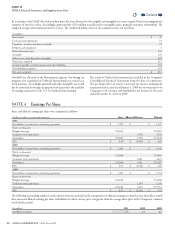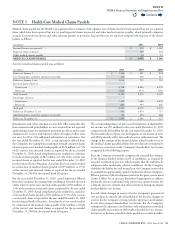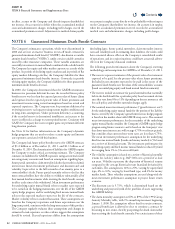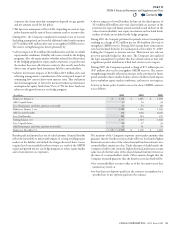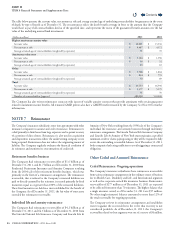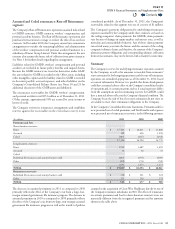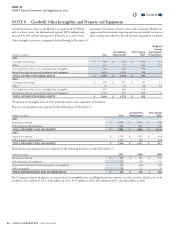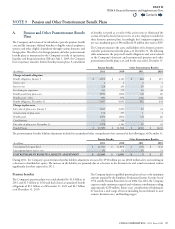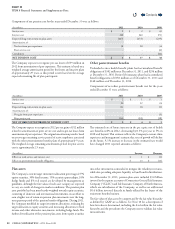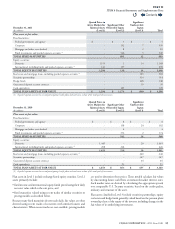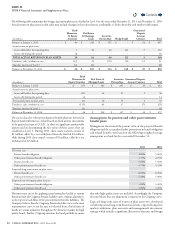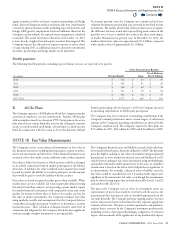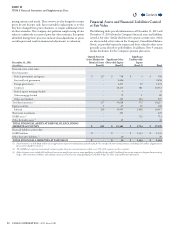Cigna 2011 Annual Report Download - page 104
Download and view the complete annual report
Please find page 104 of the 2011 Cigna annual report below. You can navigate through the pages in the report by either clicking on the pages listed below, or by using the keyword search tool below to find specific information within the annual report.
82 CIGNA CORPORATION2011 Form10K
PART II
ITEM 8 Financial Statements and Supplementary Data
in eect, accrues to the Company and directly impacts shareholders’
net income. An account is in decit when the accumulated medical
costs and administrative charges, including prot charges, exceed the
accumulated premium received. Adjustments to medical claims payable
on accounts in surplus accrue directly to the policyholder with no impact
on the Company’s shareholders’ net income. An account is in surplus
when the accumulated premium received exceeds the accumulated
medical costs and administrative charges, including prot charges.
NOTE 6 Guaranteed Minimum Death Benefit Contracts
e Company’s reinsurance operations, which were discontinued in
2000 and are now an inactive business in run-o mode, reinsured a
guaranteed minimum death benet (“GMDB”), also known as variable
annuity death benets (“VADBe”), under certain variable annuities
issued by other insurance companies. ese variable annuities are
essentially investments in mutual funds combined with a death benet.
e Company has equity and other market exposures as a result of this
product. In periods of declining equity markets and in periods of at
equity markets following a decline, the Company’s liabilities for these
guaranteed minimum death benets increase. Conversely, in periods
of rising equity markets, the Company’s liabilities for these guaranteed
minimum death benets decrease.
In 2000, the Company determined that the GMDB reinsurance
business was premium decient because the recorded future policy
benet reserve was less than the expected present value of future claims
and expenses less the expected present value of future premiums and
investment income using revised assumptions based on actual and
expected experience. e Company tests for premium deciency by
reviewing its reserve each quarter using current market conditions and
its long-term assumptions. Under premium deciency accounting,
if the recorded reserve is determined insucient, an increase to the
reserve is reected as a charge to current period income. Consistent with
GAAP, the Company does not recognize gains on premium decient
long duration products.
See Note12 for further information on the Company’s dynamic
hedge programs that are used to reduce certain equity and interest
rate exposures associated with this business.
e Company had future policy benet reserves for GMDB contracts
of $1.2billion as of December31,2011, and $1.1billion as of
December31,2010. e determination of liabilities for GMDB requires
the Company to make critical accounting estimates. e Company
estimates its liabilities for GMDB exposures using an internal model
run using many scenarios and based on assumptions regarding lapse,
future partial surrenders, claim mortality (deaths that result in claims),
interest rates (mean investment performance and discount rate) and
volatility. Lapse refers to the full surrender of an annuity prior to a
contractholder’s death. Future partial surrender refers to the fact that
most contractholders have the ability to withdraw substantially all of
their mutual fund investments while retaining the death benet coverage
in eect at the time of the withdrawal. Mean investment performance
for underlying equity mutual funds refers to market rates expected
to be earned on the hedging instruments over the life of the GMDB
equity hedge program, and for underlying xed income mutual funds
refers to the expected market return over the life of the contracts.
Market volatility refers to market uctuation. ese assumptions are
based on the Company’s experience and future expectations over the
long-term period, consistent with the long-term nature of this product.
e Company regularly evaluates these assumptions and changes its
estimates if actual experience or other evidence suggests that assumptions
should be revised. If actual experience diers from the assumptions
(including lapse, future partial surrenders, claim mortality, interest
rates and volatility) used in estimating these liabilities, the result could
have a material adverse eect on the Company’s consolidated results
of operations, and in certain situations, could have a material adverse
eect on the Company’s nancial condition.
e following provides information about the Company’s reserving
methodology and assumptions for GMDB as of December31,2011:
•
e reserves represent estimates of the present value of net amounts
expected to be paid, less the present value of net future premiums.
Included in net amounts expected to be paid is the excess of the
guaranteed death benets over the values of the contractholders’ accounts
(based on underlying equity and bond mutual fund investments).
•
e reserves include an estimate for partial surrenders that essentially
lock in the death benet for a particular policy based on annual election
rates that vary from 0% to 15% depending on the net amount at risk
for each policy and whether surrender charges apply.
•
e assumed mean investment performance (“growth interest rate”)
for the underlying equity mutual funds for the portion of the liability
that is covered by the Company’s growth interest rate hedge program
is based on the market-observable LIBOR swap curve. e assumed
mean investment performance for the remainder of the underlying
equity mutual funds considers the Company’s GMDB equity hedge
program using futures contracts, and is based on the Company’s view
that short-term interest rates will average 4.75% over future periods,
but considers that current short-term rates are less than 4.75%.
e mean investment performance assumption for the underlying
xed income mutual funds (bonds and money market) is 5% based
on a review of historical returns. e investment performance for
underlying equity and xed income mutual funds is reduced by fund
fees ranging from 1% to 3% across all funds.
•
e volatility assumption is based on a review of historical monthly
returns for each key index (e.g. S&P500) over a period of at least
ten years. Volatility represents the dispersion of historical returns
compared to the average historical return (standard deviation) for
each index. e assumption is 16% to 25%, varying by equity fund
type; 4% to 10%, varying by bond fund type; and 2% for money
market funds. ese volatility assumptions are used along with the
mean investment performance assumption to project future return
scenarios.
•
e discount rate is 5.75%, which is determined based on the
underlying and projected yield of the portfolio of assets supporting
the GMDB liability.
•e claim mortality assumption is 65% to 89% of the 1994 Group
Annuity Mortality table, with 1% annual improvement beginning
January1,2000. e assumption reects that for certain contracts,
a spousal beneciary is allowed to elect to continue a contract by
becoming its new owner, thereby postponing the death claim rather
than receiving the death benet currently. For certain issuers of these
Contents
Q


